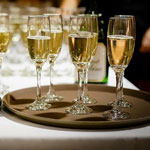Champagne Day Date in the current year: October 24, 2025
 All people who love the world’s most famous sparkling wine celebrate Champagne Day on the fourth Friday of October. The celebration is promoted by the Comité Interprofessionnel du vin de Champagne (CIVC), a trade association representing the interests of Champagne houses and independent Champagne producers.
All people who love the world’s most famous sparkling wine celebrate Champagne Day on the fourth Friday of October. The celebration is promoted by the Comité Interprofessionnel du vin de Champagne (CIVC), a trade association representing the interests of Champagne houses and independent Champagne producers.Some people use the word Champagne for all sparkling wines, but it is a common mistake. According to the rules of appellation, only sparkling wine produced in the French region of Champagne using a specific method can be called Champagne.
Sparkling wines are wines that contain significant levels of carbon dioxide, which makes them fizzy. The first sparkling wines were created accidentally; carbonation was the result of the northerly climate of the Champagne region. Fermentation would halt prematurely during cold winters and then re-start in the spring, resulting in the release of carbon dioxide into the wine.
Although originally considered a fault, sparkling wines eventually became popular with tourists, so the Champenois began to produce and export them. The production of Champagne was revolutionized by two inventions: bottles that could withstand the internal pressure from carbon dioxide and a process called riddling (remuage) that allowed to remove the lees (dead yeast deposits) from the wine while keeping the bubbles inside.
By the late 19th century, foreign winemakers who had learned the art of making sparkling wines in Champagne began to produce them in their home countries ranging from Spain to Russia. These wines are commonly referred to by their region or local name: Prosecco, Lambrusco, Asti, Cava, Sekt, etc.
In 1919, the French government passed the Law Relating to the Protection of Appellations of Origin that protected geographical indications of the origins of products. Since then, only sparkling wines produced in Champagne by traditional method according to the defined standards have the right to be called Champagne. French sparkling wines produced outside Champagne are designated Crémant or Mousseux.
In 1941, following the German occupation of France, Champagne producers formed the Comité Interprofessionnel du vin de Champagne (Interprofessional Committee for Champagne Wine) to present a unified front and continue trade under the Vichy regime. Today, one of CIVC’s most prominent activities is the protection and promotion of the Champagne appellation d’origine contrôlée (controlled designation of origin).
Champagne Day was created in 2009 by Chris Oggenfus, a Californian wine tutor and blogger. Over the years, more and more people from across the world have participated in the celebration. Due to its popularity, the holiday now has the official support of CIVC.
On the occasion of Champagne Day, Champagne producers and distributors organize vineyard tours, Champagne tasting, Champagne and food pairing workshops, and other events and activities designed to promote sparkling wines from Champagne. If there are no planned evens nearby, you can celebrate by enjoying a glass of Champagne in the company of the people you love.
- Category
- International Observances
- Tags
- Champagne Day, international observances, Comité Interprofessionnel du vin de Champagne, Chris Oggenfus, sparkling wine